Figure 1. RO 25-1553 attenuates HPV in isolated murine lungs.
A) Representative tracings of pulmonary arterial pressure (PAP; lower panel) in isolated mouse lungs perfused in the absence (control) or presence of RO 25-1553 (1 mg·mL−1) during stepwise changes in lung perfusion (Q; upper panel) at normoxia (21% O2) or hypoxia (1% O2). B) Group data showing the increase in pulmonary artery pressure (ΔPAP) relative to baseline measured 10 min after the change from normoxic (21% O2) to hypoxic (1% O2) ventilation in isolated mouse lungs perfused with buffer alone (control), with RO 25-1553 at final concentrations of 0.01, 0.1 or 1 mg·mL−1, and in lungs perfused with sildenafil (100 nMol·L−1) as positive control. C) Non-linear regression analysis according to the distensible vessel model yields representative pressure-flow (P-Q) curves for lungs perfused in the absence (control) or presence of RO 25-1553 (1 mg·mL−1) at normoxia and hypoxia. The pressure at Q = 0 ml·kg−1·min−1 reflects the LAP which was set to 2 mmHg, while the corresponding slope of the P-Q curve reflects R0. D) Group data showing intrinsic vascular resistance R0 at normoxia (21% O2) or hypoxia (1% O2) in isolated mouse lungs perfused with buffer alone (control), with RO 25-1553 at final concentrations of 0.01, 0.1 or 1 mg·mL−1, and in lungs perfused with sildenafil (100 nMol·L−1) as positive control. Group data are means±SEMs; * p<0.05 vs. control, # p<0.05 vs. normoxia, n = 8 experiments each.

